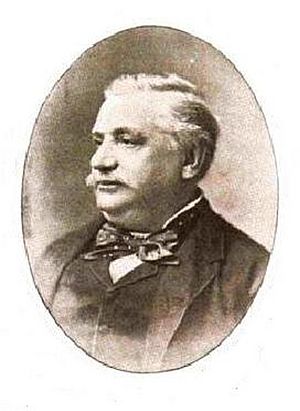Charles Ranhofer facts for kids

Portrait of Charles Ranhofer taken from the flyleaf of his book, The Epicurean.
|
|
| Born | November 7, 1836 Saint-Denis, France |
|---|---|
| Died | October 9, 1899 (aged 62) New York |
| Cooking style | Classic French |
|
Previous restaurant(s)
Delmonico, New York
|
|
Charles Ranhofer was a very famous chef from France. He lived from 1836 to 1899. He worked at a well-known restaurant in New York City called Delmonico's Restaurant. He was the head chef there for many years, from 1862 to 1876 and again from 1879 to 1896.
Ranhofer also wrote a huge cookbook called The Epicurean in 1894. It had over 1,000 pages filled with recipes! This book was a lot like Le Guide Culinaire by another famous chef, Auguste Escoffier.
Contents
Ranhofer's Cooking Journey
Charles Ranhofer started learning to cook at a young age. When he was just 12 years old, he went to Paris, France, to study how to make pastries. This was the start of his amazing career.
By the time he was 16, he became a private chef. He cooked for a prince named d'Hénin, comte d'Alsace. In 1856, Ranhofer moved to New York. There, he cooked for the Russian consul. He also worked in other American cities like Washington, D.C., and New Orleans.
Working at Delmonico's
In 1860, Ranhofer went back to France for a short time. He helped organize fancy parties for Napoléon III at the Tuileries Palace. But soon, he returned to New York. He started working at a popular restaurant called Maison Dorée.
In 1862, Lorenzo Delmonico hired him for Delmonico's Restaurant. This is where Ranhofer became truly famous. Many people say he also helped make Delmonico's one of the best restaurants in the United States. He stayed there until he retired in 1896. For a few years, from 1876 to 1879, he owned his own hotel called "Hotel American."
Famous Dishes and Recipes
Charles Ranhofer was known for creating or making popular many dishes at Delmonico's. One of the most famous was Lobster Newberg. He was also very good at naming dishes after important people. He would name them after famous guests, friends, or big events happening at the time.
Here are some examples of dishes he named:
- "Lobster Duke Alexis" was named for Grand-Duke Alexis in 1871.
- "Sarah potatoes" were named for the famous actress Sarah Bernhardt.
- "Lobster Paul Bert" was named for Paul Bert.
- "Chicken filets Sadi Carnot" was named for Marie François Sadi Carnot.
- "Peach pudding à la Cleveland" was named for President Grover Cleveland.
- "Veal pie à la Dickens" and "Beet fritters à la Dickens" were named for writer Charles Dickens. This was to honor his visit to New York in 1867.
- "Salad à la Dumas" was named for Alexandre Dumas, père, who wrote The Three Musketeers.
- "Lobster Newberg" was first named for a sea captain, Ben Wenberg. But after a disagreement, Ranhofer changed the name.
- "Marshal Ney" was a dessert named for Marshal Ney.
You can find many more dishes like these on the "List of foods named after people" page.
Baked Alaska's Popularity
While Ranhofer did not invent baked Alaska, he made it very popular. In 1876, he named it "Baked Alaska." He did this to celebrate the United States buying the land of Alaska.
Later Life and Legacy
Charles Ranhofer and his wife, Rose, had five children together. He passed away at his home in 1899 from a kidney illness. He was buried at Woodlawn Cemetery in New York. Ranhofer left behind a legacy as one of the most important chefs of his time.
See also
 In Spanish: Charles Ranhofer para niños
In Spanish: Charles Ranhofer para niños


